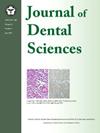Potential effect of topical antibiotics administration in the oral cavity on the reduced number of bacteria entering the lower respiratory tract after oral cancer surgery
IF 3.4
3区 医学
Q1 DENTISTRY, ORAL SURGERY & MEDICINE
引用次数: 0
Abstract
Background/purpose
One of the causes of ventilator-associated pneumonia (VAP) is aspiration of oropharyngeal fluid containing pathogenic microorganisms into the lower respiratory tract. In this study, we aimed to investigate whether antibiotic ointment applied to the oral cavity can reduce the number of bacteria in the fluid on the cuff of a tracheal cannula.
Materials and methods
Tetracycline ointment was applied intraorally once to a patient under endotracheal intubation by postoperative tracheostomy for oral cancer. The tetracycline concentrations in the oropharyngeal fluid and fluid on the cuff of tracheal cannula were determined by bioassay, and the total viable bacterial count was determined by delayed real-time polymerase chain reaction developed by the authors from before to 6 h after application.
Results
A total of seven patients were enrolled. Very high antibiotic concentrations were maintained, ranging from 481 μg/ml to 2060 μg/ml in oropharyngeal fluid and from 267 μg/ml to 858 μg/ml in fluid on the cuff from 1 h to 6 h after application. Compared to the pre-application results, the inhibition rates of viable bacteria were 80.0–97.7% for oropharyngeal fluid and 47.6%–91.9% for fluid on the cuff at 1–6 h after application, indicating that antibiotic ointment can inhibit bacteria entering the lower respiratory tract for a long period of time in intubated patients.
Conclusion
Oral application of antibiotic ointment reduced the number of bacteria entering the lower respiratory tract, suggesting that it may be useful in the prevention or treatment of VAP.
口腔局部使用抗生素对减少口腔癌手术后进入下呼吸道的细菌数量的潜在影响
背景/目的呼吸机相关性肺炎(VAP)的病因之一是含病原微生物的口咽液吸入下呼吸道。在这项研究中,我们的目的是研究抗生素软膏应用于口腔是否可以减少气管插管袖口液体中的细菌数量。材料与方法对1例口腔癌气管造瘘术后气管插管患者口服四环素软膏1次。采用生物测定法测定口咽液和气管套管袖口液中四环素的浓度,采用自行研制的延迟实时聚合酶链反应法测定给药前至给药后6 h的活菌总数。结果共纳入7例患者。维持非常高的抗生素浓度,口咽液浓度从481 μg/ml到2060 μg/ml,袖带液浓度从267 μg/ml到858 μg/ml,应用后1小时到6小时。与应用前相比,应用后1 ~ 6 h口咽液对活菌的抑制率为80.0 ~ 97.7%,袖口液对活菌的抑制率为47.6% ~ 91.9%,说明抗生素软膏对插管患者长期进入下呼吸道的细菌具有抑制作用。结论口服抗生素软膏可减少进入下呼吸道的细菌数量,提示抗生素软膏可用于预防或治疗VAP。
本文章由计算机程序翻译,如有差异,请以英文原文为准。
求助全文
约1分钟内获得全文
求助全文
来源期刊

Journal of Dental Sciences
医学-牙科与口腔外科
CiteScore
5.10
自引率
14.30%
发文量
348
审稿时长
6 days
期刊介绍:
he Journal of Dental Sciences (JDS), published quarterly, is the official and open access publication of the Association for Dental Sciences of the Republic of China (ADS-ROC). The precedent journal of the JDS is the Chinese Dental Journal (CDJ) which had already been covered by MEDLINE in 1988. As the CDJ continued to prove its importance in the region, the ADS-ROC decided to move to the international community by publishing an English journal. Hence, the birth of the JDS in 2006. The JDS is indexed in the SCI Expanded since 2008. It is also indexed in Scopus, and EMCare, ScienceDirect, SIIC Data Bases.
The topics covered by the JDS include all fields of basic and clinical dentistry. Some manuscripts focusing on the study of certain endemic diseases such as dental caries and periodontal diseases in particular regions of any country as well as oral pre-cancers, oral cancers, and oral submucous fibrosis related to betel nut chewing habit are also considered for publication. Besides, the JDS also publishes articles about the efficacy of a new treatment modality on oral verrucous hyperplasia or early oral squamous cell carcinoma.
 求助内容:
求助内容: 应助结果提醒方式:
应助结果提醒方式:


